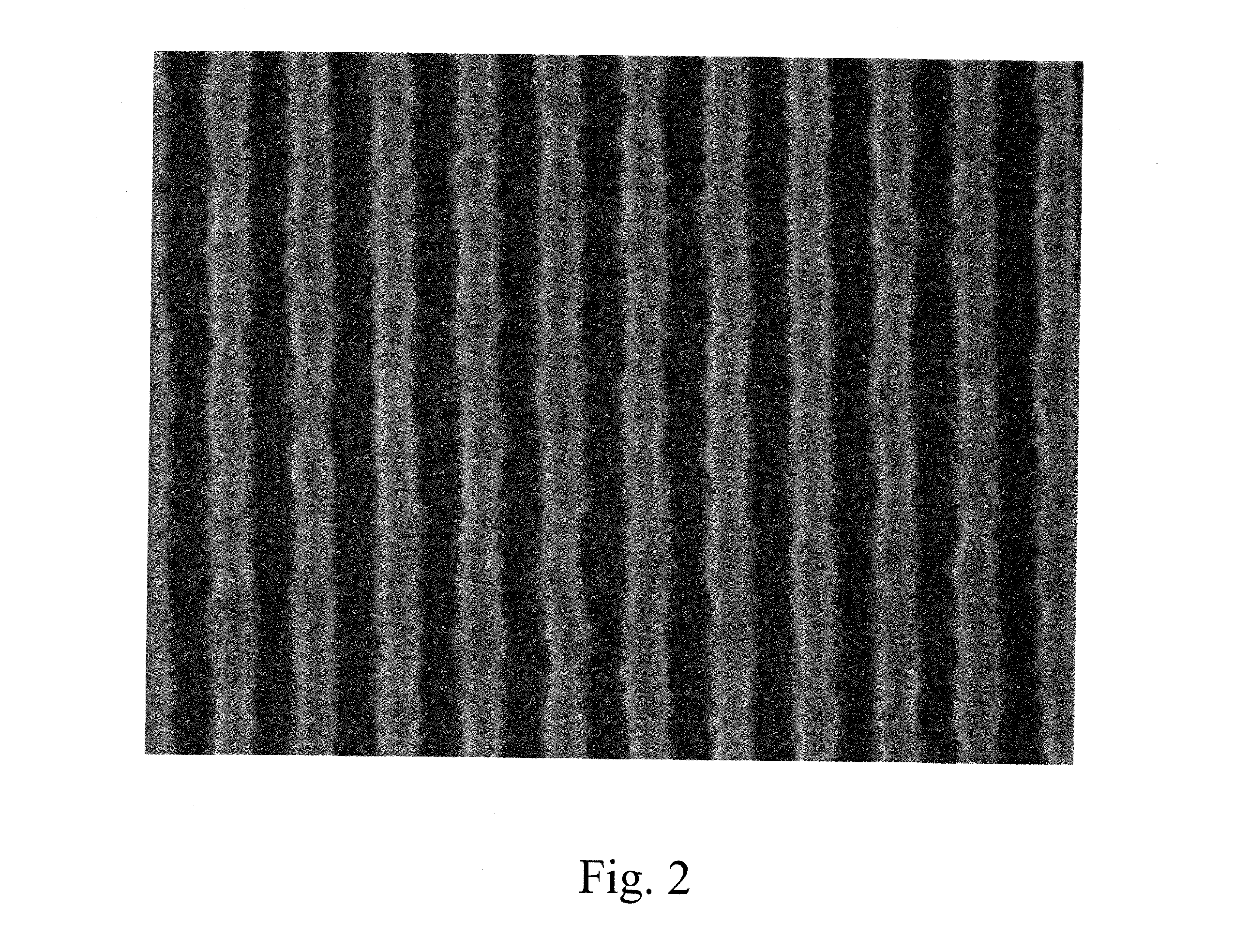Assist layers for EUV lithography
a technology of euv lithography and support layers, which is applied in the direction of photosensitive materials, instruments, photomechanical equipment, etc., can solve the problems of lack of powerful radiation sources, low throughput, and hinder the use of euv lithography, so as to improve resist performance, enhance photoresist's acid generation efficiency, and improve lwr and sensitivity
- Summary
- Abstract
- Description
- Claims
- Application Information
AI Technical Summary
Benefits of technology
Problems solved by technology
Method used
Image
Examples
example 1
Preparation of Coating Using Sol-Gel Silicon Platform
[0069]In this procedure, 7.498 grams of tetraethoxysilane (Gelest, Morrisville, Pa.), 4.998 grams of 2-(3,4-epoxycyclohexyl)ethyl trimethoxysilane (Gelest), 12.496 grams of methyltrimethoxysilane (Gelest), and 58.315 grams of PGME (Ultra Pure Solutions, Inc., Castroville, Calif.) were added to a round-bottom flask. Over a 10-minute period, a solution of 2.937 grams of acetic acid (Sigma Aldrich) and 13.756 grams of water was added to the flask while stirring. The round-bottom flask was Fitted with a distillation head, distillation column, and collection flask. The solution was heated at 95° C. for 5 hours. By-products (water and methanol) were removed during the reaction. The final solution was used as ML-2 (discussed below) directly, without further purification.
[0070]Next, 3.096 grams of ML-2, 0.155 grams of 1 wt % benzyltriethylammonium chloride (“BTEAC,” Alfa Aesar, Ward Hill, Mass.) in PGME, 67.724 grams of PGME, 29.025 grams...
example 2
Preparation of Coating Using Sol-Gel Silicon Platform
[0074]In this Example, 20.32 grams of tetraethoxysilane, 34.04 grams of 75% titanium diisopropoxide bis(-2,4-pentandionate) in isopropanol (Gelest), and 41.43 grams of PGME were added to a round-bottom flask. Over a 10-minute period, a solution of 0.70 gram of acetic acid (Sigma Aldrich) and 3.51 grams of water was added to the flask while stirring. The round-bottom flask was fitted with a distillation head, distillation column, and collection flask. The solution was heated at 95° C. for 5 hours. By-products (water and methanol) were removed during the reaction, after which 21.44 grams of the resulting solution, 5.52 grams of 0.55 wt % BTEAC in PGME, 25.10 grams of PGME, and 47.94 grams of PGMEA were mixed until homogeneous. The homogenous mixture was filtered through a 0.2-μm end-point filter to produce Formulation 2. Formulation 2 was formed into a 20-nm thick film by spin coating on a 4-inch silicon wafer at 1,500 rpm for 60 se...
example 3
Preparation of Coating Using Sol-Gel Silicon Platform
[0075]In this procedure, 15.23 grams of tetraethoxysilane, 34.20 grams of 60% zirconium di-n-butoxide bis(-2,4-pentandionate) in n-butanol (Gelest) and 46.25 grams of PGME (Ultra Pure Solutions, Inc.) were added to a round-bottom flask. Over a 10-minute period, a solution of 0.63 gram of acetic acid (Sigma Aldrich) and 2.69 grams of water was added to the flask while stirring. The round-bottom flask was fitted with a distillation head, distillation column, and collection flask. The solution was heated at 95° C. for 5 hours. By-products (water and methanol) were removed during the reaction, after which 21.86 grams of the resulting solution, 5.44 grams of 0.55 wt % BTEAC in PGME, 24.66 grams of PGME, and 48.04 grams of PGMEA were mixed until homogeneous. The homogeneous mixture was then filtered through a 0.2-μm end-point filter to produce Formulation 3. Formulation 3 was formed into a 20-nm thick film by spin coating on a 4-inch si...
PUM
| Property | Measurement | Unit |
|---|---|---|
| thickness | aaaaa | aaaaa |
| wavelengths | aaaaa | aaaaa |
| wavelengths | aaaaa | aaaaa |
Abstract
Description
Claims
Application Information
 Login to View More
Login to View More - R&D
- Intellectual Property
- Life Sciences
- Materials
- Tech Scout
- Unparalleled Data Quality
- Higher Quality Content
- 60% Fewer Hallucinations
Browse by: Latest US Patents, China's latest patents, Technical Efficacy Thesaurus, Application Domain, Technology Topic, Popular Technical Reports.
© 2025 PatSnap. All rights reserved.Legal|Privacy policy|Modern Slavery Act Transparency Statement|Sitemap|About US| Contact US: help@patsnap.com



